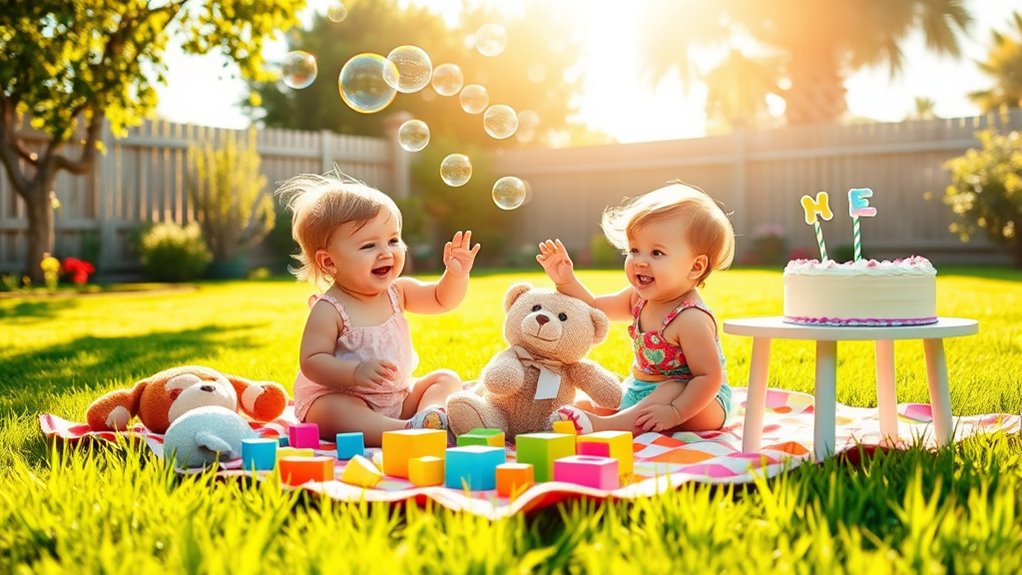Baby’s first playdate can be a fun and memorable experience. Choose a safe, neutral space like a park for relaxed interaction. Keep it simple with engaging activities like bubbles, music, and sensory play to capture their attention. Make sure toys are safe and large enough to prevent choking hazards. Providing a few snacks can also help keep the atmosphere light. With these tips, you’re well on your way to creating a joyful playdate—and there’s even more to explore!
Key Takeaways
- Choose a neutral, safe location like a park to create a relaxed environment for the playdate.
- Incorporate engaging activities like sensory play, music, or bubbles to stimulate interaction and enjoyment.
- Keep the duration to about one hour per year of age to prevent overstimulation for babies.
- Ensure toys are age-appropriate and supervise closely to maintain safety during playtime.
- Encourage parents to connect, share experiences, and build a supportive community during the playdate.

When you organize your baby’s first playdate, you open the door to a world of social and developmental benefits. It’s a chance for your little one to interact with peers, enhancing skills like smile mirroring and communication. Watching babies engage with each other can be delightful; they learn by observing actions like clapping and laughing, which helps foster their socialization skills. As they play, they’ll pick up vital sharing skills, such as passing toys back and forth, setting the stage for future interactions.
Think about what activities you want to include, as they can greatly influence the fun factor. Sensory play is a fantastic choice—set up sensory bins filled with safe textures to stimulate exploration. For a bit of movement, large, lightweight balls can encourage motor skill development while inviting interaction. Don’t forget about music and dance! A little dance party can boost everyone’s mood and energy levels. You might even consider a puppet show, as it can captivate the babies’ attention and enhance cognitive engagement. And bubbles? They’re always a hit, creating an interactive environment that brings out giggles and joy.
Incorporate sensory play, dance, and bubbles for engaging activities that spark joy and promote development during playdates.
Setting up the playdate is crucial, too. Aim for about one hour per year of your child’s age to prevent overstimulation. Neutral public spaces, like parks or playgrounds, are perfect for first-time meetups. Keep it simple with snacks and activities to create a relaxed atmosphere. Scheduling between meals can also reduce any hosting pressure, making it easier for you and the other parents.
Remember to consider safety. Ensure toys are safe, large enough to avoid choking hazards, and supervise play closely. Be aware of any allergies among the kids and maintain cleanliness by washing hands frequently. Having an emergency plan in place is also essential, just in case any little accidents occur. Additionally, observe how the babies interact as their developmental milestones may provide insights into their growth and needs.
Playdates aren’t just beneficial for babies—they’re great for you, too! They help you connect with other families, build a support system, and share parenting experiences. Regular interactions can combat feelings of isolation, making you feel more connected to the community.
Frequently Asked Questions
What Age Is Appropriate for a Baby’s First Playdate?
The appropriate age for your baby’s first playdate is between 6 to 12 months.
At this stage, babies start showing interest in other children, which helps stimulate their social development.
Early playdates focus more on adult interactions, allowing you to connect with other parents while your baby observes and learns from their peers.
This environment encourages sharing, taking turns, and cognitive growth, laying the foundation for future social skills as they grow.
How Long Should a First Playdate Last?
For a first playdate, aim for 30 to 60 minutes. This shorter duration keeps the kids engaged without overwhelming them.
You can adjust the length based on how well the children interact; if they’re having fun, you might extend it a bit. Just make sure it’s not during nap or mealtime, so they’re well-rested and ready to play.
Ending on a positive note can encourage future playdates, so plan accordingly!
What Snacks Should I Provide for Babies?
When choosing snacks for babies, opt for fresh fruits like sliced apples, bananas, and grapes, which are nutritious and easy to handle.
Yogurt smoothies blended with fruits make a tasty treat, while cottage cheese bowls offer a protein boost.
You can also create graham cracker sandwiches with cream cheese or jam.
Just remember to ensure all snacks are easy to eat and cut into manageable pieces to avoid choking hazards.
How Can I Manage Crying During the Playdate?
To manage crying during the playdate, stay calm and prepared. Use swaddling or gentle rocking to soothe your baby. Keep an eye on their cues, like fussiness, and take breaks if needed.
Create a safe environment, ensuring familiar toys are within reach. If the crying escalates, don’t hesitate to step outside for fresh air.
Should I Invite More Than One Baby for the Playdate?
Inviting more than one baby for the playdate can be like throwing a lively party where everyone’s invited to dance. It enhances social development, allowing your baby to engage with different personalities and learn from peers.
However, be cautious of overstimulation and safety concerns. Start small to gauge comfort levels, and create a safe environment.
With careful planning, you can foster connections for both babies and parents, making it a rewarding experience.
Conclusion
As you wrap up your baby’s first playdate, remember that these early connections lay the foundation for lasting friendships. Embrace the giggles and coos, and don’t shy away from the chaos; it’s all part of the delightful journey. Just like a fine wine ages to perfection, so too will these moments create cherished memories over time. So, take a breath, snap a few photos, and relish the joy of watching your little one explore this new social adventure.









